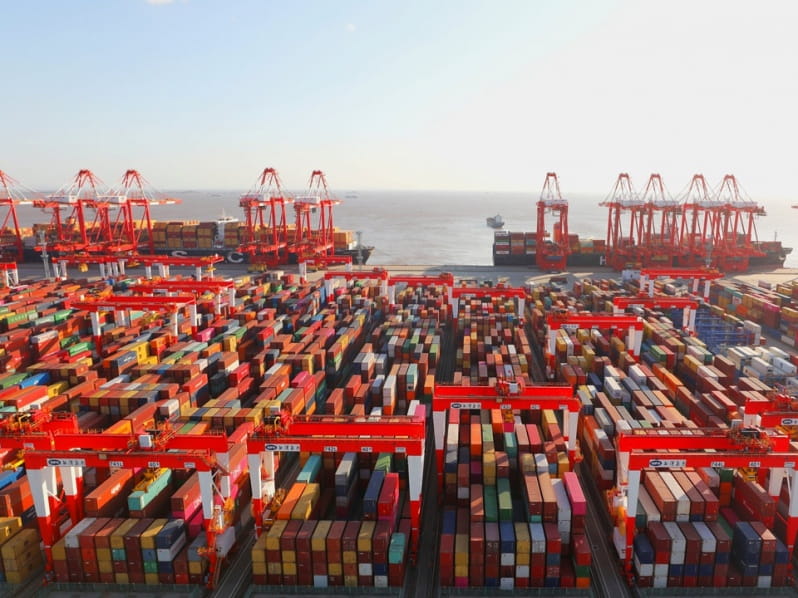In addition, there is concern about the threat of closure of the port of Shanghai due to outbreaks of Covid-19
Shipping lines continue to put more capacity on the Trans-Pacific route, apparently its most lucrative market. Also, in the last two weeks, most have added some kind of congestion charge. “How many different types of congestion surcharge can you think of? Congestion surcharge, emergency intermodal, added value, transport congestion and port congestion are just a few. And it is expected that there will be more,” says the maritime sector analyst, port and logistics Jon Monroe , for whom “each surcharge is an attempt to increase rates without increasing ocean freight, as if the shipping lines were not making enough money” and also points out that these range between US $ 350 and US $ 5,000 per container. “Rates just go up, whatever their names are . “
Among other recent industry events highlighted in his latest report, the analyst cites Hapag-Lloyd’s order for ten new 13,000 TEU vessels, which, he says, will undoubtedly operate on the Trans-Pacific route. “It seems that all the shipping lines are looking for more ships. It seems that some are transferring ships from the less profitable routes to the Trans-Pacific” he maintains and highlights in that plane the figures provided by Alphaliner, which detail that more capacity has been transferred to the Trans-Pacific route than to any other global route: “The capacity between Asia and North America has grown by 30.6% in the last 12 months. The largest increases in capacity have been those of MSC , with 81.7%, and Maersk, with 50.4% and although it is not as big as MSC and Maersk, Wan Hai added 5 new services for a capacity growth of 2,615%! “.
Situation in the United States
Jon Monroe describes that ships queue up to get a berth at the West Coast (YSWC) ports. Southern California has once again had more than 30 ships waiting to berth, Southern California terminals are incredibly jammed, due to the return of Yantian cargo ships, additional ships and charter ships that are crowding to arriving at the ports of Los Angeles and Long Beach in August.
“This may be the busiest month for Southern California’s gateway. With such a large number of ships arriving at the Los Angeles and Long Beach terminals, it is hard to imagine the impact on terminal operations. Waiting time for a berth, longer unloading times, longer time spent in the terminal and, of course, if you have containers bound for the interior, take a seat. The wait will be long, “warns the analyst.
New port closures in Asia?
According to Monroe , the resurgence of Covid-19 in Asia could slow exports to North America. Vietnam has been pretty blocked for some time, “but now the beast is making a comeback in China” and although, to be fair, China’s infection rate is very low compared to any other country, he notes that “the port of Nanjing was Blocked last week and other major cities in China may also be cut off. “
According to the analyst, this does not bode well for the port of Shanghai: “Being the largest port in the world, most of the factories located along and in the Yangtze River delta, have Shanghai as a gateway to the rest of the world. If Covid-19 were to shut down Shanghai, the impact could be much worse than in Shenzhen. “
In this sense, it details that the port of Shanghai handles approximately 40 million TEUs, a large percentage of the volume represents exports to the rest of the world. Vietnam has been closed for 5 weeks due to quarantine for the most part, which could happen anywhere and “although several analysts have pointed out that China would not risk shutting down its economy to fight Covid-19, I would not bet on it. China It will do whatever it takes to defeat the pandemic, ” Monroe warns .
Situation in Asian ports:
- Shenzhen: YICT has recovered, but USWC ports are facing a massive influx of ships from Yantian trying to fix the delays.
- Xiamen: PNW ( Pacific Northwest ) is the worst route as capacity is very low. Some shipping lines will allocate additional space in Xiamen port if the ship is overriding Yantian, but the actual space is uncertain, it should be checked on a case-by-case basis.
- Ningbo: the situation is very similar to the ports of Xingang and Qingdao, the space in the allocation could be guaranteed, but it is very difficult to get additional space even to apply the premium.
- Shanghai: Space for USEC and PNW routes is tight per week, shipping lines do not accept premium bookings, even if the customer is willing to pay high freight, there is no space that can be guaranteed.
- Qingdao: Almost all reservations have been made through the end of August and the September spaces are entering. Many shipping lines skip this port to maintain their schedule.
- Tianjin: As in Qingdao, space at USEC and PNW is extremely tight, shipping lines will guarantee space allocations, but not equipment.
- Vietnam: Shipping lines have been limiting the space allocation of Vietnam ports since November 2020, where the situation is more critical than in China. Vietnam has slowed down given the country’s lockdown due to Covid-19. Port manpower and drivers are hard to come by. The country has been under quarantine for 5 weeks.
(August 09, 2021)
New Congestion Charges: Another Way to Increase Container Shipping Rates?
Mundo Maritimo
https://www.mundomaritimo.cl/noticias/nuevos-recargos-por-congestion-otra-forma-de-incrementar-las-tarifas-del-transporte-maritimo-de-contenedores




